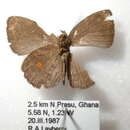Comprehensive Description
provided by Memoirs of the American Entomological Society
Epitolina dispar Kirby
Teriomima dispar Kirby, 1887: 367 ( $, Cameroon; the supposed 9, from Ashanti, is catori). Grose-Smith and Kirby, 1888 [1887-1932] (IV): 17; figs. 9, 10 [figs. 11, 12, are 5 catori]. Epitolina dispar: Aurivillius, 1920 [19081925]: 348 (including forms cordelia [pi. 64d] and melissa). Schultze, 1923: 1193. Draeseke, 1936: 43. Stempffer and Bennett, 1956: 507 (including form melissa; Liberia).
= Liptena mnestra Moschler, 1887: 63; pi., fig. 21 (Togo).
= Teriomima melissa H. H. Druce, 1888: 109 (Addah [Ghana]). Epitolina dispar melissa: Stempffer, 1952a: 185 (Togo); 1954c: 348 (Republic of Guinea).
= Teriomima cordelia Kirby, 1890: 270 (Cameroon; Gabon); Grose-Smith and Kirby, 1892 [1887-1902] (XIX): 82; figs. 9, 10.
The female which Kirby somewhat hesitantly associated with the male of dispar has a prominent orange discal patch on the forewing above. So far as I am aware this never occurs in dispar at all, females of this species being uniform fuscous above. This character, however, is characteristic of catori (see below) and a related new species from Cameroon and Gabon. In view of the locality, Ashanti, of Kirby's female I suppose that it must be a female of catori.
E. dispar may be identified readily by the uniform fuscous of the female above, the dully iridescent violet-blue of males above and the uniform fuscous fringes of both wings in both sexes, lacking the white checking that is found in catori and the undescribed species.
The under surface pattern is exceedingly variable (see Schultze, 1923), a fact that is responsible for much of the above synonymy. Somewhat arbitrarily, for there is much intergradation, a sequence of four forms may be recognized:
Form(l) ("melissa" = cordelia). The pale lines of the hindwing below are all ochre-colored, subequal in thickness and small, tending frequently to complete obsolescence.
Form (2) ("dispar'). The discal line of the hindwing below is usually composed of a round or subquadrate spot at cell-end, a smaller
- bibliographic citation
- Fox, R.M., Lindsey, A.W., Clench, H.K., Miller, L.D. 1965. The Butterflies of Liberia. Memoirs of the American Entomological Society vol. 19. Philadelphia, USA
Epitolina dispar: Brief Summary
provided by wikipedia EN
Epitolina dispar, the common epitolina, is a butterfly in the family Lycaenidae. It is found in Guinea, Sierra Leone, Liberia, Ivory Coast, Ghana, Togo, Nigeria (south and the Cross River loop), Cameroon, Equatorial Guinea, Gabon, the Republic of the Congo, the Central African Republic, Angola, the Democratic Republic of the Congo (Katako-Kombe and Sankuru), Uganda and north-western Tanzania. Its habitat consists of primary and secondary forests.
Adults have been recorded feeding from the secretions of ant-attended coccids.
- license
- cc-by-sa-3.0
- copyright
- Wikipedia authors and editors

